West Gate Bridge
The West Gate Bridge is a steel box girder cable-stayed bridge in Melbourne, Victoria, Australia, spanning the Yarra River just north of its mouth into Port Phillip. It is a vital link between the inner city (CBD) and Melbourne's western suburbs, with the industrial suburbs in the west, and with the city of Geelong 80 kilometres (50 mi) to the south-west. It is part of one of the busiest road corridors in Australia.
West Gate Bridge | |
|---|---|
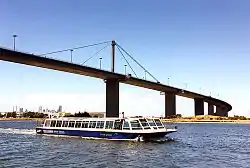 View of the bridge with a River Cruise Boat passing underneath | |
| Coordinates | 37°49′46″S 144°53′53″E |
| Carries | 10 lanes (5 inbound, 5 outbound) (after expansion) |
| Crosses | Yarra River |
| Locale | Melbourne, Australia |
| Official name | West Gate Bridge |
| Maintained by | VicRoads |
| ID number | WGB |
| Characteristics | |
| Design | Cable-stayed box girder |
| Total length | 2,582.6 metres (8,473 ft) |
| Width | Maximum of 37.3 metres (122 ft) |
| Longest span | 336 metres (1,102 ft) |
| Clearance below | 58 metres (190 ft) |
| History | |
| Opened | 15 November 1978 |
| Statistics | |
| Daily traffic | 180,000 |
| Location | |
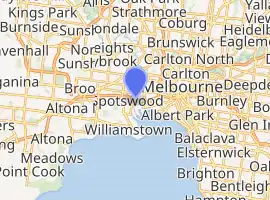
| |
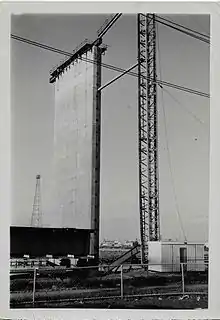
The main river span is 336 metres (1,102 ft) in length, and the height above the water is 58 metres (190 ft). The total length of the bridge is 2,582.6 metres (8,473 ft). It is the fifth-longest in Australia, the longest being Melbourne's Bolte Bridge at 5 kilometres (3.1 mi). The West Gate Bridge is twice as long as the Sydney Harbour Bridge and is one of the highest road decks in Australia, clearing the water at 58 metres (190 ft), with the Sydney Harbour Bridge clearing the water at 49 metres (161 ft).
The bridge passes over Westgate Park, a large environmental and recreational reserve created during the bridge's construction, and carries up to 200,000 vehicles per day.
Transportation
Motor vehicles
The West Gate Bridge is a 10-lane dual-carriageway freeway bridge, carrying five lanes of motor vehicle traffic in each direction. The freeway corridor (including the bridge itself) carries a very high volume and occupancy of traffic: a total of between 180,000–200,000 cars, trucks, and motorcycles use it per day, according to VicRoads. This makes the West Gate Bridge and West Gate Freeway one of the busiest road corridors in Australia.
However, being the only main direct link between Melbourne's CBD and the West, it is frequently congested during the morning and afternoon peaks (despite having five lanes in each direction) and is constantly busy 24/7 due to the number and type of vehicles coming in and out of Melbourne (i.e.) Port of Melbourne. The bridge was originally tolled. Tolls were abolished in 1985, because drivers were using other routes to avoid the toll.[1]
The bridge is rather windswept as there are no significant obstructing terrain features for some distance, particularly in the quadrant from south to west, a common wind direction. This can lead to issues for motorbikes, trucks and other high-sided vehicles in higher wind speeds, a common occurrence on this bridge. Previously wind warning lights were present at the bridge approaches to control traffic (Amber - bridge closed to motorbikes and high vehicles, Red - closed to all traffic), but the current practice now is to reduce speed limit to 40 km/h when the wind speed gets too high.
Cycling
Cyclists are prohibited from using the bridge except for special bicycle events, notably the MS Summer cycle, which is a fundraising event for multiple sclerosis, and the Around the Bay in a Day Bicycle Network[2] event that raises money for The Smith Family charity. The Westgate Punt is a foot ferry that runs directly below the bridge, taking cyclists and pedestrians across the Yarra between a jetty at Fishermans Bend near Westgate Park – Bay Trail and a jetty adjacent to Scienceworks Museum – Hobsons Bay Coastal Trail. It operates on demand, from Monday to Friday in morning and evening peaks, and on weekends and public holidays from 10:00 am to 5:00 pm.
History
Collapse
Two years into construction of the bridge, at 11:50 am on 15 October 1970, the 112-metre (367-foot) span between piers 10 and 11 collapsed and fell 50 metres (164 feet) to the ground and water below. Thirty-five construction workers were killed and 18 injured, and it remains Australia's worst industrial accident to this day.[3] Many of those who perished were on lunch break beneath the structure in workers' huts, which were crushed by the falling span. Others were working on and inside the span when it fell. The whole 2,000-tonne (4,400,000 lb) mass plummeted into the Yarra River mud with an explosion of gas, dust and mangled metal that shook buildings hundreds of metres away. Nearby houses were spattered with flying mud. The roar of the impact, the explosion, and the fire that followed, could be clearly heard over 20 kilometres (12 mi) away. On the following morning, 16 October, Sir Henry Bolte (Premier of Victoria) announced that a Royal Commission would be set up immediately to look into the cause of the disaster. The Prime Minister, John Gorton, said: "I am sure the whole of Australia is shocked and saddened by the serious accident at West Gate Bridge. Please extend my deepest sympathy to all those families to whom this tragic event has brought such grief."[4]
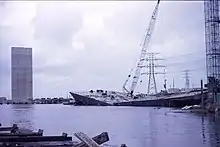
Cause
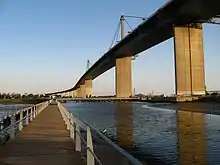
A Royal Commission into the collapse was established, which concluded on 14 July 1971. It attributed the failure of the bridge to two causes: the structural design by designers Freeman Fox & Partners, and an unusual method of construction by World Services and Construction, the original contractors of the project.
On the day of the collapse, there was a difference in camber of 11.4 centimetres (4.5 in) between two half-girders at the west end of the span which needed to be joined. It was proposed that the higher one be weighted down with 10 concrete blocks, each weighing 8 t (8.8 short tons), which were located on-site. The weight of these blocks caused the span to buckle, which was a sign of structural failure. The longitudinal joining of the half-girders was partially complete when orders came through to remove the buckle. As the bolts were removed, the bridge snapped back and the span collapsed.
Collapse memorials
Six twisted fragments of the collapsed bridge can be found adorning the gardens in the engineering faculty of Monash University, Clayton campus. It is said by students that they are to remind engineers of the consequences of their errors. Monash University acquired these when asked to participate in the investigation of the collapse.[5]
Commemorations have been held on 15 October every year since the collapse.[6] A West Gate Bridge Memorial Park to workers who lost their lives is located near the bridge. It opened on the 34th anniversary of the collapse, 15 October 2004. It includes the existing West Gate Bridge Memorial and Sculpture, and the memorial for six who died in the Spotswood Yarra Sewer Tunnel collapse of 12 April 1895 (Good Friday).[7][8]
Completion
Construction resumed in 1972 with World Services and Construction continuing to fabricate the boxes and to carry out their sub-assembly, but with John Holland Group completing the construction of the steel portion of the bridge.[9] The bridge was completed in 1978. After 10 years of construction, the bridge, a part of the larger West Gate Freeway, cost $202 million.[1]
Speed cameras were erected on the bridge in 2004, but were not activated until September 2005, because of issues with a similar camera on the Western Ring Road.[10] However these speed cameras were switched off in 2005, and currently remain disabled, as the sway of the bridge prevents secondary verification of the alleged speed against a fixed point.[11] In 2006 the State Government spent $1.3 million on erecting railway style boom barriers at each entrance to the bridge to block traffic in the event of a terrorist attack.[12] In March 2007, the State Government announced that two flagpoles would be erected atop the main bridge pylons, to fly the Australian and Victorian flags, each being 10 by 5 metres (33 by 16 ft) in size and 135 metres (443 ft) above sea level.[13] Costing $350,000 to install and $15,000 a year to maintain,[14] the flags were unfurled on 24 September 2008.[15]
On 5 August 2007, it was reported that the Victorian Government was planning a $240 million project to identify and eliminate structural weaknesses in the bridge, with specific concerns including crash barriers, cracking, corrosion and potential buckling. News of the work was prompted by the collapse of the I-35W Mississippi River bridge in Minneapolis. Experts were reported as saying the West Gate was initially designed to carry loads of 25 tonnes (55,000 lb) but now carried B-double trucks weighing up to 68 tonnes (150,000 lb). The bridge was built to carry 40,000 vehicles a day, but volumes are now more than four times the original amount, approximately 160,000 vehicles on an average day.[16]
Expansion
On 17 May 2006, the State Government as part of its Meeting Our Transport Challenges plan announced plans to change traffic flow in peak periods on the West Gate Bridge and approaches to it, using a reversible lane to provide five traffic lanes in the peak direction, opposing traffic having three lanes.[17] This was to be done using overhead signals and barriers; the State Government allocated funds to this project in its 2006–2007 state budget, but the works were never carried out.
In 2008 the expansion plans were revised as part of the Victorian Transport Plan, when it was announced that the bridge would be widened to five lanes in each direction, the space being gained by narrowing the existing traffic lanes and closing the emergency lanes, in a move criticised by Victorian fire, police and ambulance unions.[18] Overhead gantries would be used to direct traffic out of lanes when breakdowns and accidents occur. Costed at $240 million, each lane would be 3.1 metres (10 ft) wide; by comparison, lanes on the Sydney Harbour Bridge have a width of 2.8 metres (9.2 ft).[18] Roads Minister Tim Pallas claimed that the plan would allow the bridge to carry 50 per cent more vehicles, while reducing crashes by 20 per cent.[19] Structural analysis work on the bridge concluded in early 2009, and was completed over a 14-month period. Works to strengthen the bridge commenced in the first half of 2009, with the entire strengthening project scheduled for completion in 2011.[20]
On 22 June 2011, all five lanes were finally opened to the public in both directions, with the completion of the required strengthening works.[21] The full cost was $347 million, $107 million more than VicRoads had originally planned, but included considerable additional scope of works. This cost increase was after the deletion of $20 million architectural lighting originally included in the scope of the works.[21] The engineers for the strengthening project, Flint & Neill and Sinclair Knight Merz, won the 2012 Institution of Structural Engineers Supreme Award for structural engineering for the project.[22]
Flag
On 11 March 2014, a 10 metres (33 ft) artist-designed flag was raised on the western side of the bridge as part of the 'Melbourne Now' exhibition, ‘On Top of the World: Flags for Melbourne’.[23] The flag was a collaborative design between four contributing artists involved in the show who shared an affinity with the bridge. The flag design is a reference to 1803 maritime communications by Rear Admiral Home Riggs Popham, the symbol on the flag meaning ‘I can spare what you asked for’. The flag was flown until the end of the 'Melbourne Now' show on 25 March 2014.[24] Artists Brook Andrew, Helen Johnson, Kate Daw and Jon Campbell were collaborating with Stewart Russell[25] as curator.
Future
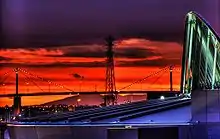

Strong growth in suburbs along the route, and increased freight through the Port of Melbourne, means that the corridor is experiencing traffic congestion during peak periods, is vulnerable to short-term interruptions, and is rapidly approaching capacity. Proposals to abate congestion by allowing more traffic have included bridge widening, a tunnel underneath the river, or adding a second deck to the bridge. Many such plans have come under fire from community groups such as the Public Transport Users Association and Environment Victoria, which advocate investment in alternative forms of transport.
A private sector report, made public in February 2006, suggested building a companion tunnel to the West Gate Bridge under the Yarra River, made up of three separate bores to carry traffic in either direction and a freight rail line. The portals would have been north of Williamstown Road in Port Melbourne, and between Blackshaws and Melbourne roads in Altona North.[26][27]
The State Government also assessed options for the development of another east–west link in 2008. Sir Rod Eddington, Chairman of the Victorian Major Events Company and former CEO of British Airways, was to head the assessment of the future east–west connections and recommend the best way forward for public transport, road and freight travel for the entire Monash-West Gate corridor. By December 2008 the State Government announced it was planning for such a link, anticipated to be a three-kilometre road tunnel under Footscray and the Maribyrnong River. Linking Dynon and Footscray Roads in the Port of Melbourne precinct to Geelong Road in West Footscray, now known as the East-West road connection, its cost is estimated at more than $2.5 billion.[28]
Incidents
Suicide location
Owing to its height, the bridge became a popular location for suicides, with police data in the early 2000s showing up to one suicide occurring every three weeks at the West Gate Bridge. A 2004 coroner's report recommended anti-suicide fencing or barriers be erected on the bridge to deter people from attempting to end their lives.[29]
Those who argued for a suicide barrier claimed that most of those who jump from the West Gate Bridge do so through impulse, and that police officers who tried to save jumpers were putting their own lives in danger. There were reported incidents of police officers dangling off the side of the bridge while holding onto would-be jumpers.[30] A 2000 Royal Melbourne Hospital study on people who jumped from the bridge found at least 62 cases between 1991 and 1998. Seven people survived the 58-metre (190 ft) fall. Around 74 per cent of those who jumped from the bridge were male, with an average age of 33. More than 70 per cent were suffering from mental illness.[31] Of those who jumped off the West Gate Bridge, 31 per cent fell onto land. Some of those who landed in water drowned afterwards.[32]
Installation of anti-suicide fencing
In June 2008, Gabriela Garcia jumped off the West Gate Bridge with her 22-month-old son Oliver, and their bodies were found on the river bank below.[33]
Seven months later on 29 January 2009, a 4-year-old girl, Darcey Freeman, was thrown off the bridge by her father, Arthur Freeman. She survived the fall but later died in hospital. Freeman was found guilty of murder and sentenced to life in prison in April 2011;[34] the apparent trigger for the incident was his recent separation and apparent fear of loss of access to the children (similar to the 2005 Robert Farquarson case).
A week after that incident, on 5 February 2009, 17 year old Allem Halkic jumped from the inbound lanes near the Todd Road exit on the Port Melbourne side of the bridge. He walked up the bridge from the KFC at the Todd Road exit, and was reported to have said to the Vicroads operator via the Emergency Phone (no longer operational as they were abolished along with the Emergency Stopping Lane's in 2011) 'you better get someone here before I jump'. Police responded within minutes of this, and initially struggled to find Allem as there was a length of fencing along the length of the bridge that ran alongside Westgate Park (installed in 2006 as a counter terrorism measure). They eventually did find him, however he was unable to be resuscitated and died at the scene. The case gained notoriety as Halkic was a victim of cyberbullying in the days prior to this, thus he was deemed the first death caused by cyberbullying in Victoria. In October 2011 a coronial inquest was held into the death, again recommending, among other things, the installation of anti-suicide barriers. [35] [36]
Following these incidents, a temporary suicide barrier of concrete crash barriers topped with a welded mesh fence was erected from February 2009. A permanent metal mesh barrier was subsequently installed along the length of the bridge in 2010-11 at a cost of $20 million.[18] The barrier is reported to have reduced suicides from the bridge by 85 per cent.[37]
See also
- List of disasters in Australia by death toll
- List of bridge disasters
- West Gate Freeway
- Erskine Bridge
- Tasman Bridge
- Cleddau Bridge
- Suicide bridge
References
- M.G. Lay & K.F. Daley (July 2002). "The Melbourne City Link Project". Transport Policy. 9 (3): 261–267. doi:10.1016/S0967-070X(02)00020-3.
- "Bicycle Network - Making bike riding easier for everyone". Bicycle Network. 10 April 2017. Archived from the original on 23 March 2018. Retrieved 7 May 2018.
- "Forty years on, the West Gate Bridge collapse still looms large". The Age. 16 October 2010. Archived from the original on 12 May 2017.
- 'West Gate', Bill Hitchings, 1979, Outback Press. ISBN 9780868882260
- "West Gate garden". www.monash.edu. Monash University. Archived from the original on 1 September 2017. Retrieved 28 July 2017.
- "Commemorations". www.westgatebridge.org. West Gate Bridge Memorial Committee. Archived from the original on 7 January 2016. Retrieved 9 August 2015.
- "Memorial park". West Gate Bridge. Archived from the original on 7 January 2016. Retrieved 9 August 2015.
- "The Sewer Accident" (scan). The Argus (No. 15, 232). Melbourne. 25 April 1985. p. 6. Retrieved 9 August 2015 – via trove.nla.gov.au.
- "Commencement of works". West Gate Bridge Memorial. Retrieved 4 January 2020.
- Ashley Gardiner (21 September 2005). "Bridge cameras set to bring in millions". Herald Sun. Australia.
- Matthew Shulz (22 May 2008). "Malfunctioning West Gate Bridge speed cameras turned off". Herald Sun. Australia.
- Tanya Giles (18 January 2008). "West Gate boom gates to fight terror". Herald Sun. Australia. Retrieved 25 September 2008.
- "FLAGS TO FLY ON THE WEST GATE BRIDGE". Media Release: OFFICE OF THE PREMIER. legislation.vic.gov.au. 13 March 2007. Archived from the original on 2 April 2011. Retrieved 25 September 2008.
- Lucas, Clay; Dowling, Jason (17 September 2008). "Pride in the flags to cost $350,000". The Age. Melbourne, Australia. Archived from the original on 10 February 2016. Retrieved 25 September 2008.
- Ashley Gardiner (25 September 2008). "West Gate Bridge shows flag colours". Herald Sun. Australia. Archived from the original on 27 September 2008. Retrieved 25 September 2008.
- Paul Heinrichs (5 August 2007). "$240m West Gate facelift to bridge safety fears". The Age. Melbourne, Australia. Archived from the original on 28 December 2007. Retrieved 18 June 2009.
- State of Victoria (May 2006). Meeting Our Transport Challenges (Report).
- Clay Lucas (5 December 2008). "Police, ambulance unions criticise move to close West Gate emergency lanes". The Age. Melbourne, Australia. Archived from the original on 7 December 2008. Retrieved 18 June 2009.
- "No emergency on West Gate Bridge". ABC News. Australia: ABC. 4 December 2008. Archived from the original on 7 December 2008. Retrieved 18 June 2009.
- "West Gate Bridge Strengthening". Monash-CityLink-West Gate upgrade. mcwupgrade.com.au. Archived from the original on 31 May 2009. Retrieved 18 June 2009.
- Clay Lucas (23 June 2011). "Costs head north as another lane goes west". The Age. Australia. Archived from the original on 25 June 2011. Retrieved 27 June 2011.
- IStructE. "2012 IStructE Supreme Award Winners". UK. Retrieved 12 December 2012.
- "Artists' flag raised on West Gate Bridge". ngv.vic.gov.au (Press release). National Gallery of Victoria. 10 March 2014. Retrieved 9 August 2015.
- http://www.ngv.vic.gov.au/melbournenow/projects/007 Melbourne Now Archived 13 March 2014 at the Wayback Machine
- "Archived copy". Archived from the original on 30 April 2015. Retrieved 7 August 2015.CS1 maint: archived copy as title (link)
- Australian Associated Press (6 February 2006). "$2bn tunnel plan for West Gate Bridge". The Age. Melbourne, Australia. Archived from the original on 8 February 2006. Retrieved 18 June 2009.
- John Ferguson & Geraldine Mitchell (18 February 2008). "Traffic on Melbourne's West Gate Bridge slows under heavy load". Herald Sun. Australia: news.com.au. Archived from the original on 18 February 2008. Retrieved 18 June 2009.
- "West Gate Bridge Alternative". Victorian Transport Plan. www4.transport.vic.gov.au. December 2008. Archived from the original on 5 June 2009. Retrieved 18 June 2009.
- Mark Dunn & Anthony Dowsley (14 June 2008). "Anti-suicide barrier urged for West Gate Bridge". Herald Sun. Australia: news.com.au. Archived from the original on 4 March 2009. Retrieved 18 June 2009.
- Mark Dunn (9 November 2006). "Police risk lives on death bridge". Herald Sun. Australia: news.com.au. Retrieved 18 June 2009.
- Karen Poh (10 June 2008). "Fence on bridge". Star News Group. starnewsgroup.com.au. Archived from the original on 3 August 2008. Retrieved 18 June 2009.
- Coman M, Meyer AD, Cameron PA (2000). "Jumping from the Westgate Bridge, Melbourne". The Medical Journal of Australia. ncbi.nlm.nih.gov. 172 (2): 67–9. doi:10.5694/j.1326-5377.2000.tb139202.x. PMID 10738475. S2CID 24946258.
- Mark Dunn & Antonia Magee (5 June 2008). "Mum and baby dead in 'gut-wrenching' tragedy". Herald Sun. Australia: news.com.au. Archived from the original on 7 June 2008. Retrieved 18 June 2009.
- Thomas Hunter (11 April 2011). "West Gate father sentenced to life in prison". The Age. Australia: www.theage.com.au. Archived from the original on 10 September 2011. Retrieved 7 June 2012.
- https://www.coronerscourt.vic.gov.au/sites/default/files/2018-12/allemhalkic_065509.pdf
- https://www.heraldsun.com.au/news/special-features/web-of-threats-ended-in-allem-halkics-death/news-story/7adb407178523bf30937b7602cbdb8fc?sv=9da8f1546204ee93797fd7b31b8601
- "West Gate barriers 'reducing suicides'". www.heraldsun.com.au. 14 April 2011. Retrieved 21 October 2020.
External links
- West Gate Bridge Memorial
- Public Record Office of Victoria's special site on the Westgate Bridge collapse
- "Report of the Royal Commission into the Failure of West Gate Bridge" (PDF). Archived from the original (PDF) on 27 May 2016. (3Mb) 1971
- Worksafe Victoria
- West Gate Bridge at Structurae